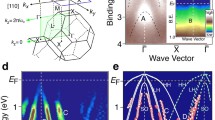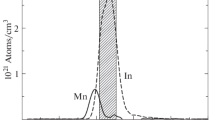Abstract
An electron-spin resonance technique has been used to examine the influence exerted by the degree of compensation on spin effects in a set of nonmagnetic Ge:As semiconductor samples in the vicinity of the insulator–metal phase transition at temperatures 2 K ≤ T ≤ 80 K. It was found that the behavior of the paramagnetic susceptibility, specific to the Pauli paramagnetism and manifested in the spin density resonance, is drawn deep into the insulator state and is observed up to rather large degrees of compensation K ≈ 0.7 at temperature 20 K ≥ T ≥ 5–10 K. Outside this temperature range, both the quantities rapidly grow with increasing compensation and their behavior approaches the Curie law characteristic of the strong insulator state. The reason for this behavior is that the degeneracy is lifted at high temperatures and, at low temperatures, electron states are localized at the Fermi level as a result of the Coulomb blockade by compensating acceptors of the most closely lying donor states and the resulting formation of a narrow Coulomb band in the metallized impurity band. At temperature T ≥ 5–10 K, the gap is blurred by thermal excitations and has no effect on the manifestation of the Pauli paramagnetism. The behavior of the line width of the electron-spin resonance is determined by the scattering on quasi-stationary electric dipoles created by the Coulomb blockade at low temperatures and by the scattering on phonons at high temperatures. The behavior of the g-factor is qualitatively correlated with the specific features of the paramagnetic susceptibility and spin density: with decreasing temperature it weakly grows in the range of the Pauli paramagnetism and then rapidly increases in the range in which the Coulomb blockade is manifested and a transition occurs to the Curie law. By an analogy with ferromagnetic materials in which such a fast increase in the g-factor is observed, the possibility of a compensation caused ferromagnetic coupling of spins localized on donors. The microscopic model of such a coupling is discussed.













Similar content being viewed by others
Notes
For the s-state of impurity electrons, Peff = 1.
The Curie law for paramagnetics without spin interaction is obeyed in a wide temperature range, being only disrupted with the Zeeman splitting of spin levels in the magnetic field, kT ≤ ΔE.
In these terms, we use the analogy with the classical spin glass, generalized to the case of antiferromagnetic or ferromagnetic spin coupling.
It is noteworthy that the critical, for the IM transition in Ge:As, arsenic concentration is somewhat higher: 3.7 × 1017 cm−3.
In these terms, we use the analogy with the classical spin glass. The term “characteristic region” as applied to the Neel temperature, and, below, to the Curie temperature, emphasizes the fact that there actually is a distribution of these quantities around certain averaged values in the disordered system of the spin glass.
For this purpose, a certain “average” temperature T = 15 K was chosen, around which the g-factor is nearly independent of temperature.
A quasi-stationary electron vacancy is formed on a donor at sufficiently low temperatures, when the thermal excitation energy of an electron in the impurity band is insufficient for its excitation to a free donor state uplifted by the electrostatic field of the nearest acceptor (Coulomb blockade effect).
For example, these electron vacancies are responsible for the hopping electron conductivity via the impurity band.
References
S.V. Vonsovskii, Magnetizm. Magnitnye svoistva dia-, para-, ferro-, antiferro- i ferrimagnetikov Magnetism. Magnetic Properties of Dia-, Para-, Ferro-, Antiferro-, and Ferrimagnetics) (Nauka, Moscow, 1971)
C.M. Нurd, Varieties of Magnetic Order in Solids. Contemp. Phys. 23(5), 469–493 (1982)
M.A. Paalanen, S. Sachdev, R.N. Bhatt, A.R. Ruckenstein, Phys. Rev. Lett. 37, 2061 (1986)
A.I. Veinger, A.G. Zabrodskii, T.V. Tisnek, E.N. Mokhov, Fiz. Tekh. Poluprovodn. 37, 874 (2003)
A.I. Veinger, A.G. Zabrodskii, T.V. Tisnek, S.I. Goloshchapov, Fiz. Tekh. Poluprovodn. 41, 812 (2007)
A.I. Veinger, A.G. Zabrodskii, T.V. Tisnek, S.I. Goloshchapov, Fiz. Tekh. Poluprovodn. 42, 1301 (2008)
A.G. Zabrodskii, A.I. Veinger, T.V. Tisnek, S.I. Goloshchapov, Appl. Magn. Reson 35, 439 (2009)
A.I. Veinger, A.G. Zabrodskii, T.V. Tisnek, S.I. Goloshchapov, P.V. Semenikhin, Tech. Phys. 58, 1806 (2013)
A.G. Zabrodskii, A.I. Veinger, P.V. Semenikhin, Phys. Status Solidi B, 1900249 (2019)
M. Reznikov, A.Y. Kuntsevich, N. Teneh, V.M. Pudalov, JETP Lett. 92, 470 (2010)
N. Kobayashi, S. Ikehata, S. Kobayashi, W. Sasaki, Solid State Commun. 24, 67 (1977)
Y. Liu, G. Wang, S. Wang, J. Yang, L. Chen, X. Qin, B. Song, B. Wang, X. Chen, Phys. Rev. Lett. 106, 087205 (2011)
T.L. Makarova, A.L. Shelankov, I.T. Serenkov, V.I. Sakharov, D.W. Boukhvalov, Phys. Rev. B 83, 085417 (2011)
A.V. Rode, E.G. Gamaly, A.G. Christy, J.G. Fitz Gerald, S.T. Hyde, R.G. Elliman, B. Luther-Davies, A.I. Veinger, J. Androulakis, J. Giapintzakis, Phys. Rev. B 70, 054407 (2004)
A.G. Andreev, S.V. Egorov, A.G. Zabrodskii, R.V. Parfen’ev, A.V. Chernyaev, Fiz. Tekh. Poluprovodn. 34, 796 (2000)
M.A. Garcia, E. Fernandez Pinel, J. de la Venta, A. Quesada, V. Bouzas, J.F. Fernández, J.J. Romero, M.S. Martín González, J.L. Costa-Krämer, J. Appl. Phys. 105, 013925 (2009)
A.G. Zabrodskii, Fiz. Tekh. Poluprovodn. 14, 1324 (1980)
A.G. Zabrodskii, Fiz. Tekh. Poluprovodn. 14, 1492 (1980)
M.V. Alekseenko, A.G. Zabrodskii, L.M. Shterengas, Fiz. Tekh. Poluprovodn. 32, 811 (1998)
A.I. Veinger, A.G. Zabrodskii, T.V. Tisnek, S.I. Goloshchapov, P.V. Semenikhin, arXiv:Condmat:1301.6026 (2013).
C.P. Poole, Electron Spin Resonance: Comprehensive Treatise on Experimental Techniques (Wiley, New York, London, Sydney, 1967), p. 546
J.E. Wertz, J.R. Bolton, Electron Spin Resonance: Elementary Theory and Practical Applications (Wiley, Sydney, 1967)
D.K. Wilson, Phys. Rev. 134, A265 (1964)
N.F. Mott, Metal-Insulator Transitions (Taylor and Francis Ltd, London, 1990), p. 286
C. H. Kamimura, Crystalline Semiconducting Materials and Devices, P.N. Butcher, N.H. March, M. Tosi (eds.) (Springer Science & Business Media, Berlin, Germany 1986), p. 646
N.W. Ashcroft, N.D. Mermin, Solid State Physics, (Holt (Rinehart & Winston, New York, 1976), p. 826
A.G. Zabrodskii, Philos. Mag. B81, 1131 (2001)
Acknowledgements
The authors are grateful to N. A. Poklonskii for helpful discussions. The study was financially supported by the Presidium of the Russian Academy of Sciences (Program No. 1.4 “Actual problems of low temperature physics”).
Author information
Authors and Affiliations
Corresponding author
Additional information
Publisher's Note
Springer Nature remains neutral with regard to jurisdictional claims in published maps and institutional affiliations.
Rights and permissions
About this article
Cite this article
Zabrodskii, A., Veinger, A. & Semenikhin, P. Effect of Compensation on Low-Temperature Spin Ordering in Ge:As Semiconductor Near the Insulator–Metal Phase Transition. Appl Magn Reson 51, 327–347 (2020). https://doi.org/10.1007/s00723-019-01181-1
Received:
Revised:
Published:
Issue Date:
DOI: https://doi.org/10.1007/s00723-019-01181-1




